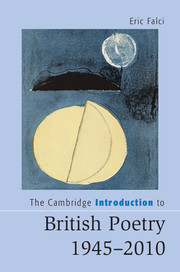Book contents
- Frontmatter
- Contents
- Acknowledgments
- Introduction
- Chapter 1 The Movement and Its Discontents
- Chapter 2 Decolonizing Poetry
- Chapter 3 Local Modernism
- Chapter 4 Late Modernism
- Chapter 5 The North
- Chapter 6 New Narratives
- Chapter 7 Platforms and Performances
- Conclusion: Archipelagic Experiments
- Notes
- Further Reading
- Index
- Cambridge Introductions to Literature
Chapter 5 - The North
Published online by Cambridge University Press: 05 November 2015
- Frontmatter
- Contents
- Acknowledgments
- Introduction
- Chapter 1 The Movement and Its Discontents
- Chapter 2 Decolonizing Poetry
- Chapter 3 Local Modernism
- Chapter 4 Late Modernism
- Chapter 5 The North
- Chapter 6 New Narratives
- Chapter 7 Platforms and Performances
- Conclusion: Archipelagic Experiments
- Notes
- Further Reading
- Index
- Cambridge Introductions to Literature
Summary
By devoting a separate chapter to the body of poetry connected with the outbreak of violence in Derry in October 1968 and the ensuing thirty-year period of strife known as “the Troubles,” I do not mean to imply that Northern Irish poetry is entirely self-contained. The poets at the core of this formation – Seamus Heaney, Michael Longley, Derek Mahon, John Montague, Paul Muldoon, Tom Paulin, Medbh McGuckian, and Ciaran Carson – certainly constitute a closely linked community akin to those that featured in previous chapters, but they also have deep ties with British, American, and European poets. I also do not intend this chapter to offer a comprehensive account of Northern Irish poetry, nor, of course, of post-Yeatsian poetry from the Irish Republic. My aim, rather, is to register and comprehend the significance of poetry from Northern Ireland in relation to developing canons of contemporary poetry in the British Isles. Northern Irish poets have become increasingly well known in Britain and the United States since the 1970s, and the massive size of Heaney's British readership alone speaks to the centrality of Northern Irish poets to the concerns of this book. Heaney was, along with Ted Hughes, by far the best-selling poet in the U.K. for the last decades of the twentieth century; and for periods in the 1990s and 2000s, Heaney's books accounted for two thirds of all contemporary poetry volumes sold in Britain.
The importance of the Troubles within the postwar history of Britain makes it imperative to understand Northern Irish poetry within a larger historical context, and the complexity of that history shapes my decision to consider it in a discrete chapter. As part of the treaty that ended the Anglo-Irish War (1919–1921), the island of Ireland was partitioned into two entities. The Irish Free State (Éire) made up the bulk of the island and became politically independent from Great Britain (it remained for a time a dominion of the British Empire but left the Commonwealth in 1937 and became the Republic of Ireland). Northern Ireland, consisting of six counties in the northeast part of the island (Fermanagh, Armagh, Antrim, Down, Tyrone, and Londonderry), remained part of Britain. The historical province of Ulster included an additional three counties (Monaghan, Donegal, and Cavan) that were incorporated into the Irish Free State.
- Type
- Chapter
- Information
- The Cambridge Introduction to British Poetry, 1945–2010 , pp. 126 - 154Publisher: Cambridge University PressPrint publication year: 2015

